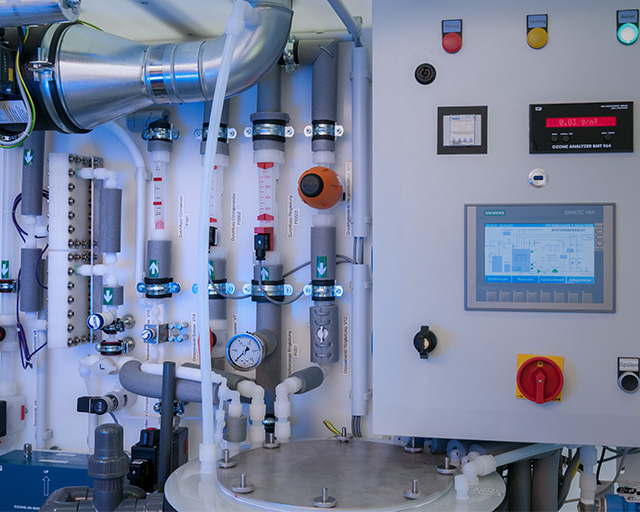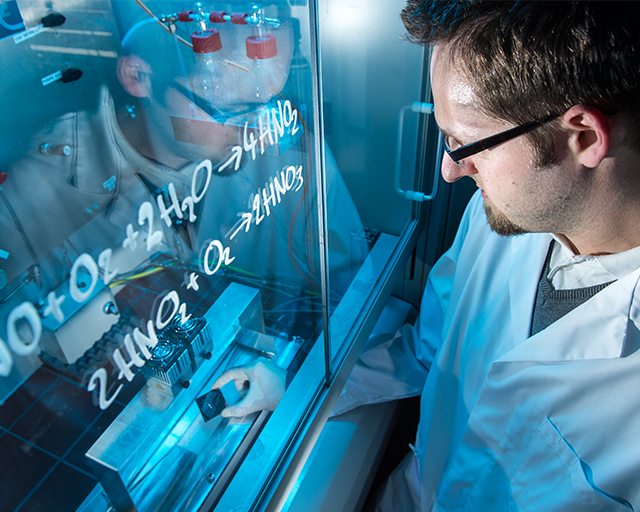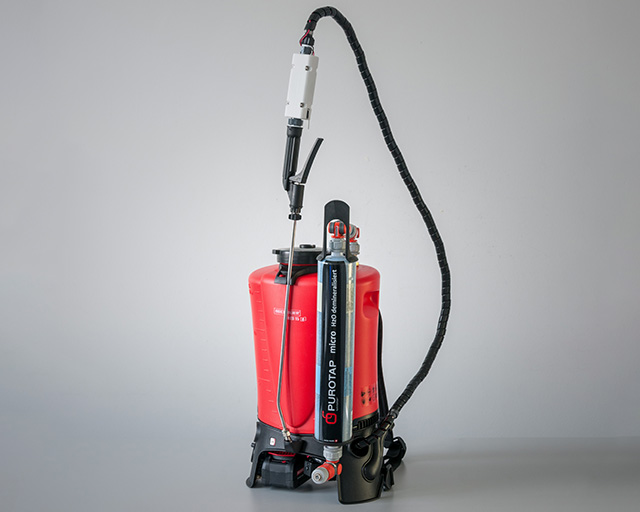
Photo- and electrochemical environmental technologies




Sustainable technologies for a clean environment
Photo- and electrochemical oxidation processes are an important building block in the degradation of organic substances. Furthermore, they contribute towards the environmentally-friendly extraction of hydrogen and the conversion of carbon dioxide (CO2) into higher-value hydrocarbons. At the Fraunhofer IST, the preferred methods are electrochemical oxidation using diamond electrodes (EAOP®) and photochemical oxidation and reduction with photocatalysis. Neither of the two processes uses any additional chemical substances and they are therefore among the most environmentally friendly and sustainable technologies available on the market.
System solutions for the reduction of emissions and pollutants
We develop and test system solutions for the sustainable and efficient purification and disinfection of water, air and soil as well as for the synthesis of basic chemicals. We are one of the pioneers of EAOP® technology as well as being a major player in photocatalytic metrology, scaling and standardization, and our customers therefore benefit from the flexible networking of our competences for the production, evaluation and adaptation of diamond electrodes and photocatalytic surfaces taking into account the limitations of economic efficiency and environmental sustainability. Our technology is applied in energy-efficient diamond cells with which micro-pollutants in groundwater, drinking water and wastewater are degraded, in the coating and treatment of surfaces in order to protect against fouling and biofouling, and in disinfection systems for agricultural production and agricultural hygiene.
”Our CleanTech processes dispense with the need for additional chemicals and therefore provide a valuable contribution towards the environment and the climate-compatible assurance of an adequate supply of water, energy and food.”
Dipl.-Ing. (FH) Frank Neumann, Team Manager
Mobile DiaDis plant for the production of ozonized water
Ozonized water is produced in an electrochemical process and made available for various applications. In this process, ozone, a strong oxidant, is generated extremely energy-efficiently from the water molecules using diamond electrodes directly in the water. It can be used to reduce fouling on RO membranes and to prevent biofilms in ultrapure water or cooling systems. Alternatively, the system can be used to kill viruses, germs and pests, for example to disinfect surfaces or to improve plant growth.

Specifications / technical data
- Medium: deionized water with a conductance < 1µS/cm
- Usable volume: 10 - 100 liters (variable)
- Active substance: ozone (O3) dissolved in deionized water
- O3 concentration: up to 10 mg/l
- Ozone output: 200-250 mg/h dissolved O3 at 20°C
- Dimensions: 1500 x 750 x 1950 mm (W x D x H)
- Weight: 280 kg (empty), 400 kg (operation)
Standard-compliant measuring station for photocatalytic air purification
The measuring station allows the evaluation of the performance of photocatalytic air-purifying surfaces in accordance with ISO 22197-1 to -4, EN 16980-1, DIN 19279 as well as pursuant to the guidelines of the German Federation for applied Photocatalysis (FAP). In addition to development-supporting order analytics, the Fraunhofer IST offers its customers a turnkey solution for determining the photocatalytic activity of their products and for demonstrating the sustainable and safe reduction of environmentally hazardous and toxic pollutants in indoor and outdoor areas.

Specifications / technical data
- Applicable test standards: ISO 22197-1 to -4, EN 19680-1, DIN 19279
- Possible test gases: NO, NO2, (O3), HCHO, C2H4O, C7H8
- Reactors: directional flow flat-bed reactor, continuous stirred tank reactor
- Dimensions: 900 x 900 x 2700 mm (W x D x H)
Mobile backpack sprayer for the disinfection of surfaces
Among the commonly used disinfectants, ozone in dissolved form in water allows safe application, particularly for indoor use. However, ozone dissolved in water quickly decomposes and requires immediate production on site. As a self-sufficient system, the mobile backpack sprayer developed at the IST enables the production of a disinfectant agent without the use of additional chemicals. Through the integration of diamond electrodes, the ozone is generated quickly and efficiently directly in the water and can thus ensure the sustainable disinfection of surfaces.

Specifications / technical data
- Backbone: REB 15 PC3, Birchmeier Sprühtechnik AG
- Medium: city water (via ion exchanger); deionized water with conductance < 5 µS/cm
- Usable volume: up to 15 l; approx. 2 l/h
- Active substance: Ozone (O3) dissolved in deionized water
- O3 concentration: up to 1 mg/l dissolved O3 at 20°C
- Weight: 5 kg (empty), 28 kg (operation)